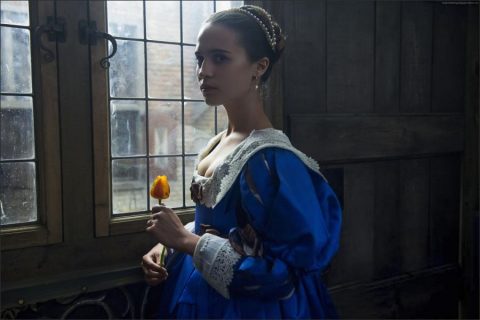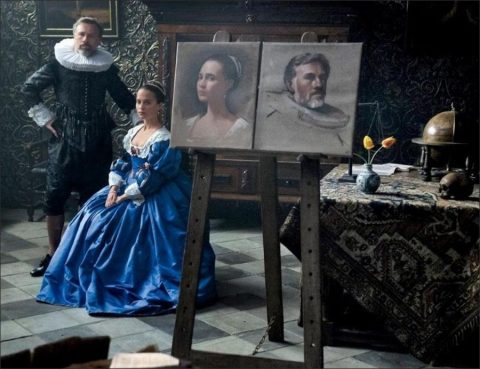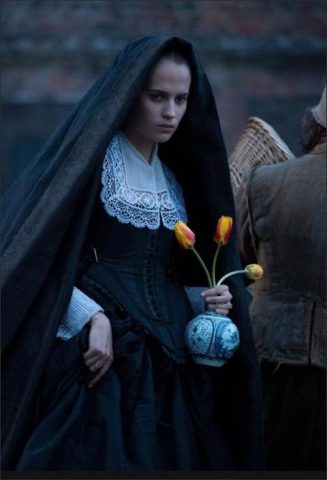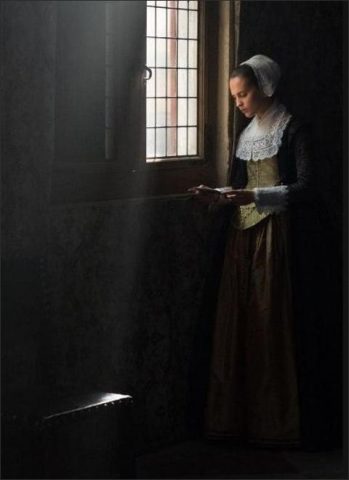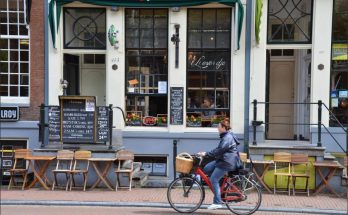The Tulip Fever movie is finally being released. Set in the 17th century Holland, the film tells the story of a painter. Our reviewer Oksana Sanzharova watched the movie and shared her glimpse on the paintings that inspired the film’s creators so that the viewers could catch the spirit of the era.
Tulip Fever is a historical drama film, adapted from a novel of the same name by Deborah Moggach. The greatest living classic playwright Tom Stoppard was invited to write the script («Rosencrantz and Guildenstern are dead,” „Shakespeare in love“). The director is Justin Chadwick, who already had a costume movie listed in his filmography, ”The Other Boleyn Girl».
Holland in 1730’s was made of dirty channels, tall and narrow houses of dull red brick, black clothes, white collars of the respectable citizens, almost impeccably cleaned rooms where they lived, and «tulip fever», a real insanity over the rare varieties of the flower.
And, of course, a sudden love that «leaped out of nowhere and struck as lightning, as a Finnish knife», a forbidden love, since the heroine of the film is not that happy, but perfectly legally married. The heroine’s cheating is excused only by the fact that her husband, the «pepper king» Cornelis van Sandvoort, a middle-aged, rich and childless widower, took a portionless girl as his wife exclusively for her beauty; and now he expects comfort, tenderness and, of course, the heirs from the profitable acquisition.
Obviously, he gets nothing. In this story, very few people get something: the main characters do not get happiness, the participants of the tulip fever do not get money, the viewers do not get a happy end. Though there`s something they will surely receive: an excellent job of the costumers, decorators, director of photography, and those inventive people who literally stuffed the film with highly recognizable quotes from the 17th century Dutch painting.
Surprisingly, the most successful quotation came not to the main characters, but to the heroine’s husband, whose image is an undeniable reference to the portraits by Frans Hals, created in those happy years when his painting with neglected fineness was praised by rich clients.
«Portrait of Willem Heitheissen,” this parody of the ceremonial portrait, is a real playful hymn to the Dutch merchant class. A rich grain trader is depicted against the backdrop of a magnificent curtain, leaning on a huge sword like a cane, that only emphasizes his small height. The roses and ruins scattered on the background not only make the setting noble, but also remind us about the fragility of this world.
Sofia, the young wife of the «pepper king», as it would seem, should look like the heroines of another great artist, mysteriously twinkling with a pearl earring or at least demonstrating a yellow jacket with an ermine decoration that Vermeer of Delft liked to paint. None of a kind! At the beginning, her image of «a quiet mouse in a white cap» has very little of Vermeer’s temptation. Such young women in Dutch portraits practically do not exist separately, their fate is to take the canvas on the right on a pair of the wedding portraits or to play music and read letters in numerous «interiors».
The strong contrast to the measured and rather dull life of the poor (though already rich) Sofia makes the full life of her housekeeper Mary (on whose behalf the story is telling). This young lady, starring Holliday Grainger, is a round-faced, laughing girl who frequently visits the fish shop (because the fishmonger is very handsy). She is associated not just with one painting, but a lot of Dutch and Flemish paintings, from stately cooks of Pieter Aertsen to maidens by Pieter de Hooch.
Pieter de Hooch. A Woman and her Maid in a Courtyard
Wishing to capture his I-am-rich-my-house-is-a-full-cup-a-beautiful-wife-is-beside-me happiness, a merchant is looking for an artist to create a family portrait of high quality and low price (50 guilders mentioned in the film was not that high for that time).
The scene of the searches of «talented and non-drinker» painter is illustrated by the adventures of a merchant’s attorney, who moves around Amsterdam, squeezing girls along the way, like all the «prodigal sons in taverns» painted by all Dutch artists together.
France Hals. Young man and woman in the hotel (Junker Ramp and his sweetheart)
Despite the strict Protestant morality, images of courtship and matchmaking were very popular. Moreover, they could always be described as illustrations to the Old Testament parables. Appearing at the call of the merchant, a painter named Jan van Loo probably should be associated with the most famous and well-known Dutch master of that time, Rembrandt. This is achieved by simple tools: shabby curls, moustache, and a lamellar collar, familiar to us from Rembrandt’s numerous self-portraits.
Though, let`s be honest — despite the fact that the charm of Dane De Haan (who recently played a super-agent Valerian in the new Luc Besson film) is rather negative than positive, his appearance is much more pleasant than Rembrandt Harmens van Rijn, who for most of his life was similar to the average hobbit. By the way, real painters with the name of van Loo lived at that time, for example, Jacob van Loo, the younger contemporary of Rembrandt.
Having listened to the customer, the artist realized he would have to paint not the usual double portrait with each spouse on a separate canvas, but the portrait of both of them. He immediately suggested adding the symbol dear to a Dutch heart: the globe, informing that the owner of the house is engaged in trade, the scales for the souls to be weighed on the Day of Judgment, and a skull, reminding that paintings are vanity.
There was nothing strange in the proposal to add the skull to the composition, as the theme of «vanitas» — the perishable bustle — could be interwoven into a wedding portrait, a still life with pie and chees, or a genre scene with a fun drink.
France Hals. Portrait of a man with a skull
But at this moment the master’s wife appeared in a luxurious blue dress, unlike her everyday black and white outfits, and all the thoughts about the vanity of existence flew out of the painter’s head. By the way, the headdress with pearls, in which Sofia is sitting, can be found in the painting of Jan Verspronck.
Jan Cornelisz. Verspronck. Portrait of Maria van Strijp (detail).
Sitting for the artist without her husband and listening to his compliments to the blue dress, that will be painted with the same precious ultramarine that the cloak of the Virgin was painted with, Sophia understands that a handsome young artist is much more interesting than a middle-aged man with an ordinary appearance.
What is shown to the audience next, perhaps, is the only everyday theme that is not sufficiently reflected in the Dutch painting of the 17th century. Artists depicted a lot the preparatory stages of the adultery — doctors’ visits to imaginary patients, reading and writing letters, sharing wine and lemonade, but the act of carnal love was usually depicted in scenes of mythology. However, the possible prototype of our hero Jacob van Loo had several erotic scenes and nude beauties, more like townspeople than nymphs or biblical heroines.
All this touching romance takes place with the background searches for the bulbs of white and red tulips, the auctions, where a bulb of a rare grade could be sold for the price of a four-horse carriage, and Rembrandt’s favorite light solutions — a white collar, a glitter of metal or the face distorted by a grimace looming out of darkness by a lantern or candle.
In the intervals between modestly erotic scenes that were shot on the excessively large bed for the Holland of that time, the artist finally painted his «Woman at the Window», which probably should have something in common with Vermeer. It should, but it does not, because the one who was responsible for the creation of «picturesque products by Jan van Loos» in the film crew, does not feel Dutch painting of the XVII century well. It is especially obvious with the wrong blue color, which is too modern and too far from the precious Vermeer`s ultramarine.
The paintings of the fictional Jan van Loos were produced by an artist Jamie Routley (born 1982) for the film. Below are the works of Routley, which are shown in the film. It is clear to anyone that such idyll could not continue for a long time. The maid found out that she was pregnant, so she threatened to reveal the secret of the mistress to her husband (not for nothing Dutch artists painted maids listening and peeping at the mistresses so often), and Sofia offered her «to exchange pregnancies». Of course, such a forgery is impossible without a doctor, so one of the favorite scenes of the Dutch painters — of the sick and the doctor — also awaits the viewer.
The scenes with doctors visiting real, and more often imaginary patients, were popular among Dutch masters. Often they hinted at a possible affair of a heroine with a doctor, or the remedy from all of her suffering could be a lover.
While Sofia and her maid deceit Cornelis van Sandvoort in an inventive way, her lover decides to earn money for a joint escape and a prosperous life, selling a bulb of a rare white-red tulip. And, of course, it makes no good, except that the audience is repeatedly shown one more favorite setting of Dutch artists, the church interiors. Images of the internal space of the Gothic churches were very popular in XVII century Holland.
When you look at these light-flooded temples there is a feeling, that the artists bypassed their own, internal secularization of art in this way, drawing if not God himself, then His house. At last the time of childbirth arrived, Sophia managed to disguise the child for her own one, then she (with the help of a doctor) suddenly «died of the plague» (so that her husband did not have a particular desire to delay the funeral) and left the house in the coffin. A scene with the widowed Cornelis and the maid, holding the baby by the breast, is an undeniable and rather malicious allusion to the Holy Family. The resemblance of an elderly merchant to the old Joseph is obvious, in spite of his suit with a white linen collar.
However, soon van Sandvoort was also robbed of this ghostly family — the fishmonger returned to the maid, she no longer agreed to be a fostermother for her own daughter. At this point, the melodrama suddenly turned into a Christmas fairy tale, and the merchant, who left his house to happy parents, set off to cure the broken heart in the East Indies (where the good filmmakers promised him happiness and a new family). Surprisingly, but Hals has a portrait of the same Willem van Heythuysen for this case, with a wistful and sad smile of a man swaying in the chair.
Meanwhile, the precious bulb of the striped tulip was accidentally eaten, like an ordinary (and very tasteless) onion, and unhappy Sophia disappeared for several years, leaving poor van Loos with a firm knowledge that love is not eternal, life is frail, and it`s all vanity of vanities, and all you have to paint are fading tulips and a skull to remember about the futility of everything.
This still life with white-red tulips of Semper Augustus was painted in 1639, two years after the completion of the «tulip fever». In Haarlem, the artist’s hometown, a bulb of this variety was purchased for 6,000 guilders (approximately 21 kg of gold). This festive bouquet may thus refer to the transience of earthly matters. Lizard and caterpillar are symbols of decay, snail stands for lust.
Related Link: All About Tulip Fever Movie
